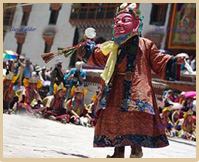Tours
Life of Buddha
Buddhist Tour
Losar Festival in India

One of the most important festivals of the Tibetan Buddhists, Losar celebrates the Tibetan New Year. The term Losar derives from two words of Tibetan language, Lo which means new and sar which means year.
In Tibet, Losar is celebrated for a period of over 15 days, however, in India, the festivities are now restricted to 3 days. In India, Losar is celebrated wherever the Buddhists reside. Below are given details of how Losar is celebrated in few places in India.
Losar in Ladakh
In Ladakh, people celebrate Losar on the first day of the eleventh lunar month. The reason for this is the tradition set by the 17th century king, Jamyang Namgyal. During his reign, he decided to lead an expedition against the Balti forces, however, he was advised not to do anything of the sort since the new year was just round the corner. What Jamyang Namgyal did to appease the people and still go ahead with his intentions was rather interesting. He shifted the new year two months before the actual date. So, Ladakh, now celebrates its new year on the 1st day of the eleventh lunar month. Preparation begin on the 29th day of the tenth lunar month. People stock provisions including goats, sheep and grains for evening feast with relatives. Houses and shrines are illuminated with lights in the evening itself. On the day of the new year, people hang images of ibex, symbol of fertility, on the doors and walls of the kitchen. Also, ibex images made of dough are placed on the shelves of the kitchen to bring that extra good luck.
People offer prayers and greetings to various gods as well as elders and relatives of the family. The younger members of the family go out to pay a visit to the relatives in area while the elder stay back to receive their younger relatives who come along with a gift like khatak (ceremonial) scarf. The Muslims and the Christans of Leh to make it a point to visit their Buddhist friends on the eve of Losar.
The procession of fire, 'Metho' takes place in the evening. The streets and bazaars of Leh come alive as the villagers bearing flaming torches pass through chanting slogans. These slogans are meant to ward off evil spirits and hungry ghosts - the result of bad Karma (one's deeds). The procession ends with the torches being thrown out of the town to bid adieu to the old year and welcome the new year.
Losar in Himachal Pradesh
In Himachal pradesh, Losar is celebrated in areas dominated by the Buddhist or where there is a presence of Buddhists. The monasteries located in the Lahaul district of the state are some of the best places to enjoy the festival. The monasteries put up wonderful performances including the spectacular chaam dances wherein monks dress up in elaborate costumes and maske and depict the victory of good over evil.
Losar in Sikkim
Losoong marks the conclusion of the harvest season in Sikkim and also the end of the tenth month of the Tibetan year. Sonam Losar or the agricultural new year is celebrated in Sikkim during this time in December-January. There is an abundance of rice and grains and the weather is quiet moderate which is quiet opposite to actual new year time in February when it is chillingly cold. The actual new year, also known as Gyalpo Lossar is marked by feasting and merrymaking. In Pemayangtse, chaams or devil dances are held two days before the losar and are quiet similar to the ones performed during Losoong.








